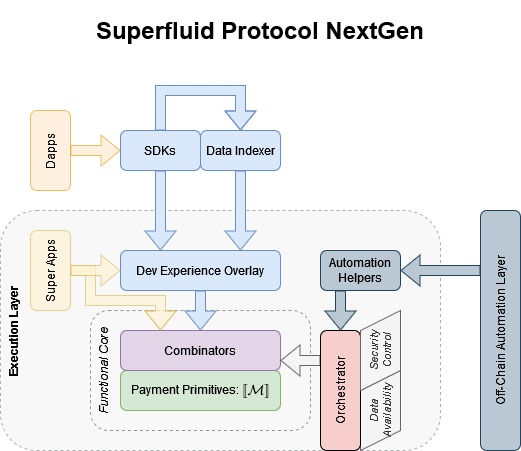First Yellowpaper About Superfluid Protocol, the Beginning of Something Greater
Where Are We
We, builders of the Superfluid Protocol, have come a long way.
EVMv1 of Superfluid Protocol has been live on Polygon (then Matic Network) since a year and a half ago (May 2021). Since then, we have been live in 5 more networks, including Gnosis Chain (then xDAI Chain), Optimism, Arbitrum, Avalanche, and BNB Chain.
The significant features of the protocol are:
- ERC-20/ERC-777 (1to1 instant payment primitive) compatible super token,
- 1to1 constant flow payment primitive,
- 1toN instant distribution payment primitive,
- a buffer-based solvency framework,
- a multi-roles-and-continuous auction system for it called "TOGA,"
- a callbacks-based compositional framework called "Super Apps,"
- a super-token-native batch call before it was cool.
We have had many new product announcements, community project launches, and hackathon winners — all of which you can read about on the Superfluid medium blog.
We are fully committed to building products that expand the reach and adoption of the EVMv1 of Superfluid Protocol. For this, we invite everyone to participate in our roadmap public board, helping us shape them together.
Something Greater
First of all, the reason why we are here is that there is a central observation guiding us; consequently, we are motivated by a strong belief in how payment systems can become:
Payment systems in the information age are still modeled after their analog predecessors. We can modernize it.
Meanwhile, we are planning for an extended period of focused building for this cycle. Namely, we want to expand the depth and breadth of the idea behind the Superfluid Protocol.
More Depth
Yellowpapers & Stronger Foundation
As the first step to expand the depth of the protocol, I am happy to announce that the first yellowpaper of its series about the most fundamental part of the Superfluid idea is now available: "Denotational Semantics of General Payment Primitives, and Its Payment System."
The paper first explores the foundation of modern payment systems, which consists of a money distribution model, payment primitives, payment execution systems of financial contracts, and different forms of money mediums. Then the paper uses denotational semantics to formally define payment primitives for modern payment systems. Lastly, this paper also includes an overview of the Superfluid Protocol, a reference implementation of the payment primitives, and its payment system.
Here are some of the topics future yellowpapers will explore:
- Composing payment primitives of modern payment systems.
- A deterministic buffer-less modern payment execution environment.
- A note (EUTXO) based modern payment execution environment.
These are some cross-cutting concerns of modern payment systems; they form a stronger foundation to build future Superfluid Protocol implementations.
Next Generation Architecture
Here is a sneak peek into how that next generation Superfluid Protocol implementation could look like:

Execution-Layer Agnostic
The architecture is deliberately execution-layer agnostic to prepare for a many-chains world.
That means deferring the decisions related to the specificity of the execution layer towards as much edge as possible, such as "dev experience overlay," "data availability," etc.
Functional Core & Data Availability
A functional core means that we apply the functional programming style to the core part of the protocol, namely (a) using denotational semantics to define payment primitives, (b) pushing data availability out of the core, (c) and composing payment primitives through combinators.
The advantages of such architecture are that:
- It ensures we can better reason the system's security,
- abstracting data availability so that we can try new methods such as gas-optimizing data serializations, ad-hoc merkle tree data rollups, ZK Proofs, FHE (Fully Homomorphic Encryption), etc.,
- thinking in combinators enables powerful compositionality.
Overlay & Tooling for Dev Experience
From our experience in EVMv1, a distinct separation between core and peripherals (including dev experience overlay) should unshackle creativity in token/note interface design.
In the off-chain world, data indexers and SDKs are the critical pieces to unlock the complete development experience for the dapp developers.
Super Apps Power-Ups
Super Apps will also get power-ups from the more sound core and the better dev experience overlay, so developers should expect to build safer Super Apps easier.
Automation
Unlike EVMv1, where we added the ACL feature for automation later, the off-chain automation system will be part of the integral design of the system from day 1.
More Breadth
Superfluid Protocol EVMv2
We will still maintain our strong focus on EVM blockchains and start to work towards the EVMv2 Superfluid Protocol.
Non-EVM Prototypes
At the same time, bringing ideas behind the Superfluid Protocol everywhere is our longer-term dream. Therefore, to avoid the risk of premature favoritism, we shall not mention any particular blockchains; nonetheless, it suffices to say that a grant-seeking approach will be favored when exploring other chain implementations.
Get Involved
We’re excited to launch our yellowpaper series, and hope it helps evolve the discussion around what a modern payment system could and should look like. We have yet to publicize any research-related job posts, but if our yellowpaper series interests you and you’d like to be part of it, please visit http://jobs.superfluid.fiance or send your CV to jobs@superfluid.finance!



